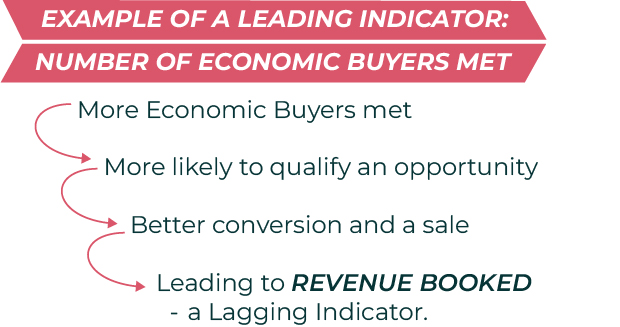The importance of leading indicators

Leading indicators are vitally important to understand the health of your business.
Whether you are:
- A founder driving self-created pipeline
- A sales rep starting in a new territory
- A sales leader running a team
you can’t ignore leading indicators.
Go to:
- What do leading indicators mean in sales?
- Leading vs lagging indicators
- Example of a leading indicator
- Leading indicators and onboarding
- How to implement leading indicators with MEDDIC/MEDDPICC
- Leading indicators to motivate and develop
What do leading indicators mean in sales?
The term "leading indicators" is used in sales to track small wins in the following situations:
a) In the early days of creating new pipeline
b) When closing business in a new territory
In these examples, it is often too early to judge whether you will see success in your endeavours.
However, by using Leading Indicators, you can measure the little wins along the way. These little wins will add up to the Lagging Indicators and achievements that are expected further down the line.
Leading vs lagging indicators
Leading indicators is the term given for those early key performance indicators (KPIs) for sales pipeline.
These early KPIs are the ones that are realised before the real KPIs that we want to drive.
Such as pipeline created or revenue closed.
Essentially, it’s how we know our direction of travel and that we are on the road to success.
Leading indicator KPIs can be created for any business, however in sales we would usually consider 2 main categories for leading indicators:
- Pipeline creation leading indicators
- Pipeline progression leading indicators
1. Pipeline creation leading indicators could be things like:
- The number of leads registered through the website
- The number of outbound calls made
- The number of discovery meetings held
- Opportunities registered in the CRM
all within a given time period.
2. Pipeline progression leading indicators would be more like:
- The numbers of meetings held in existing opportunities
- Meetings logged with an Economic buyer/C-Suite
- Meetings with different people across an account
again, within a period.
Lagging indicator KPIs in sales would usually be:
- Qualified pipeline
- Revenue booked
The leading indicators show activity which should lead to lagging indicators.
A lagging indicator is the ultimate result needed.
Example of a leading indicator

Leading indicators and onboarding
We’ve talked previously about onboarding from a founder perspective in this blog.
The reality of onboarding is that pipeline and revenue take time to realise. This is true for new hires or people on new territories. Leading indicators are important to track, review and measure.
Leading indicators become our compass that we are on the right road. That, based on the calculations or assumptions we make, the result should come.
For example, a new sales hire will probably not close any revenue in the first 6 months, so we can’t judge performance by this measure.
On the flip side we also can’t wait for the 6 months to pass to see if they will achieve. Therefore, we might judge success by:
- Number of new customers contacted (email/phone)
- Number of new customers met (in meetings with agreed agendas)
- Number of demos completed
- Achievement of pipeline generation goals (in numbers or value)
These are just examples, but show we are thinking about activity which will lead to sales in the end.
As you get beyond the early pipeline generation stage, you can also use leading indicators to qualify opportunities as they start to progress through the pipeline too.
How to implement leading indicators with MEDDIC/MEDDPICC
We often get asked about our recommendation for the best leading indicators for MEDDIC/MEDDPICC based implementations—our advice here is to keep things simple.
Here are a few ideas:
- Opportunities created and Identified pain and Metrics documented
Why?
This demonstrates that reps can create pipeline with a clear market fit identified.
- Number of meetings with "the Champion"
Why?
Meetings with the target Champion show propensity to buy. Risks are flagged up in too many or too few meetings with a key player.
- Number of meetings where management has met the Champion
Why?
Champions, like opportunities, must be qualified. Has a second person qualified the opportunity and therefore the Champion?
There are many more possible measures, but these are a good place to start.
The three ideas above will help with easy qualification of early opportunities that act as signposts that success could be on the horizon.
Leading indicators to motivate and develop
To be clear, leading indicators shouldn’t be used just as a measuring stick of a good hire.
Leading indicators can tell us a lot about individuals and where they are succeeding or struggling.
They can inform development plans for our new hires to ensure we are supporting them with everything they need.
Also, in the early days of sales onboarding, the "little wins" that leading indicators give, can act as a motivational aid to demonstrate success – for the employee as much as for the employer.
Use leading indicators as an aid to help employee engagement and success. The more you applaud and encourage those early-stage wins to success, the more motivated employees will be to stay on the journey to the ultimate goals of new customer acquisition and revenue.
If you are interested in new ideas, inspir’em sales meeting exercises and lesson plans are available to continue the development journey of your teams.
Contact us today to further boost your sales and see your revenue grow.
For more tips on applying MEDDIC in the real world - join our community at inspir’em today.


